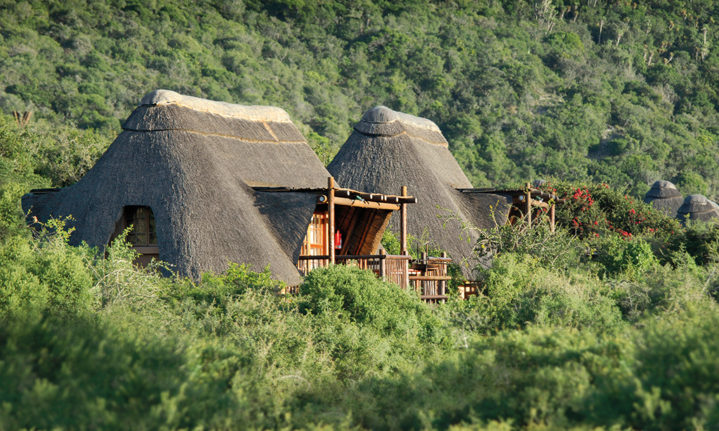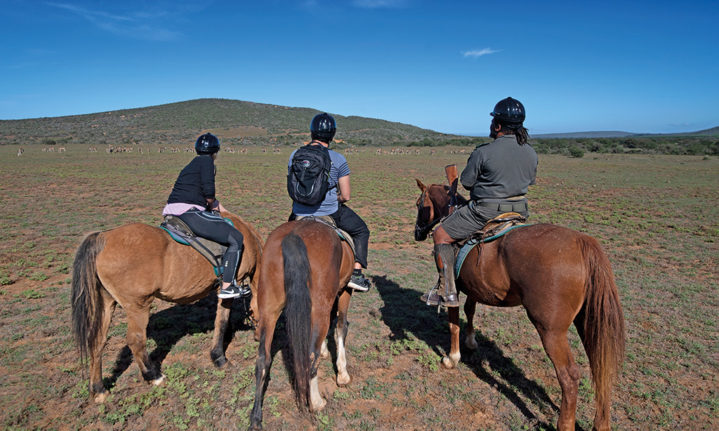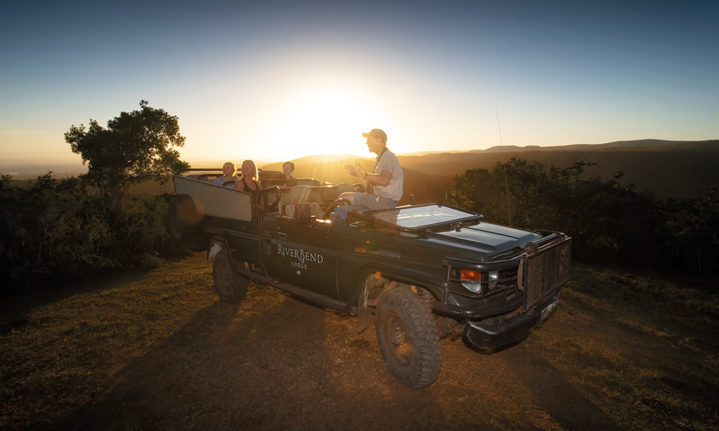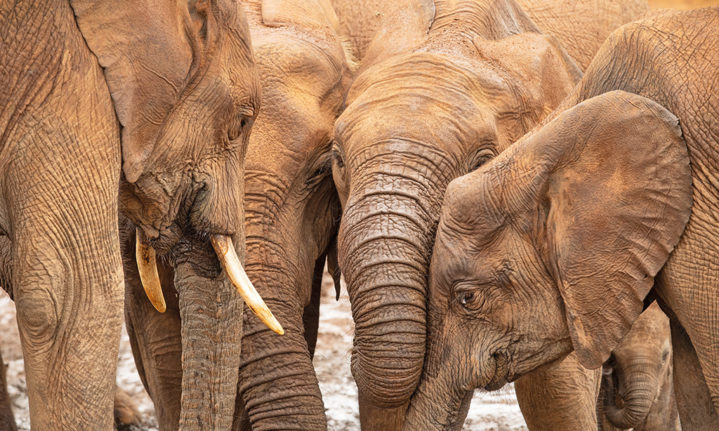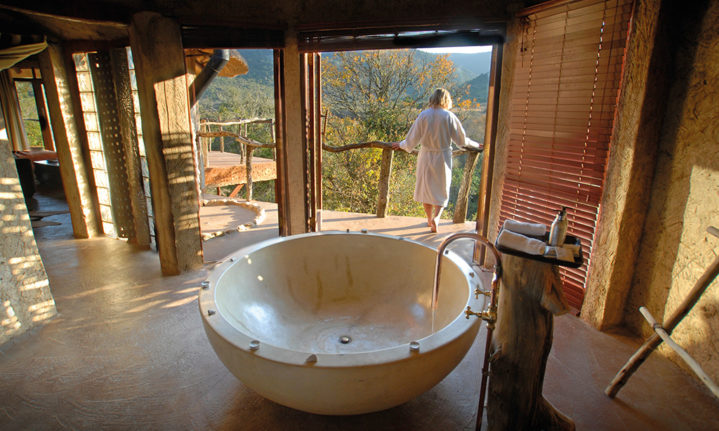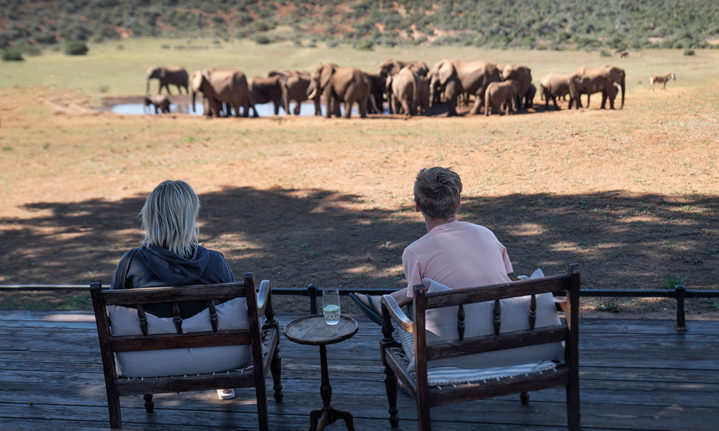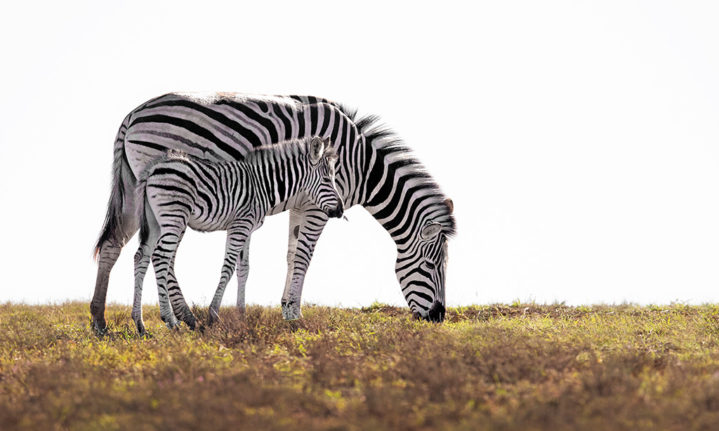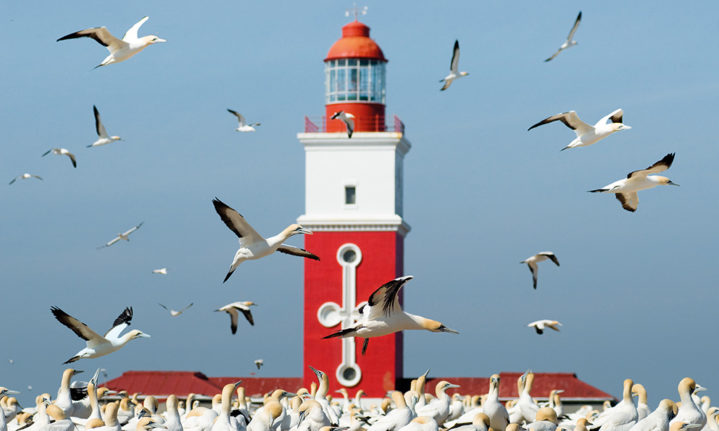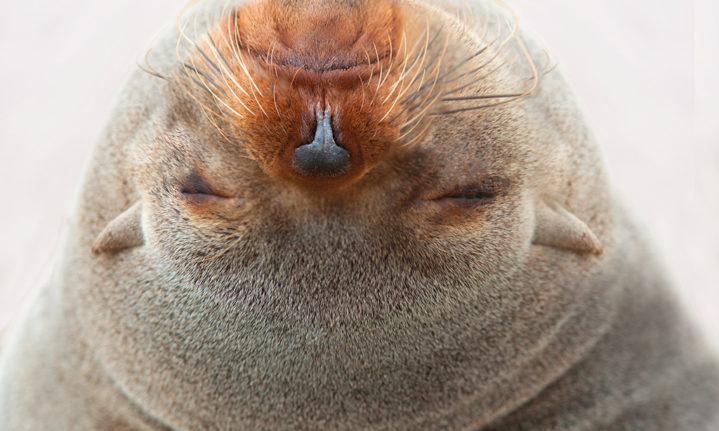Stretching from the Karoo to the islands in Algoa Bay, Addo is a vast conservation area protecting all manner of flora and fauna, from meerkats to marine life, semi-arid scrubland to coastal woodland. The action adventure starts here.
Words & Photos: Dale R Morris

Addo started out with just 11 elephants. It now has around 700. There have been various translocations throughout the years, including moving bulls from Kruger to keep Addo’s elephant gene pool healthy.
Standing aboard the Raggy Charters tour boat, parked next to the guano-stained rocks of Algoa Bay’s Bird Island, I sucked in a lungful of salty air and watched in awe as a tornado of Cape gannets circled around a red and white lighthouse.
There were thousands of them; tens of thousands perhaps; swirling like a blizzard over the sea, diving into the water and raining down destruction on any ill-fated fish below. I saw a whale nearby, too – a humpback by the looks of it – and next to her, a pod of bottlenose dolphins.
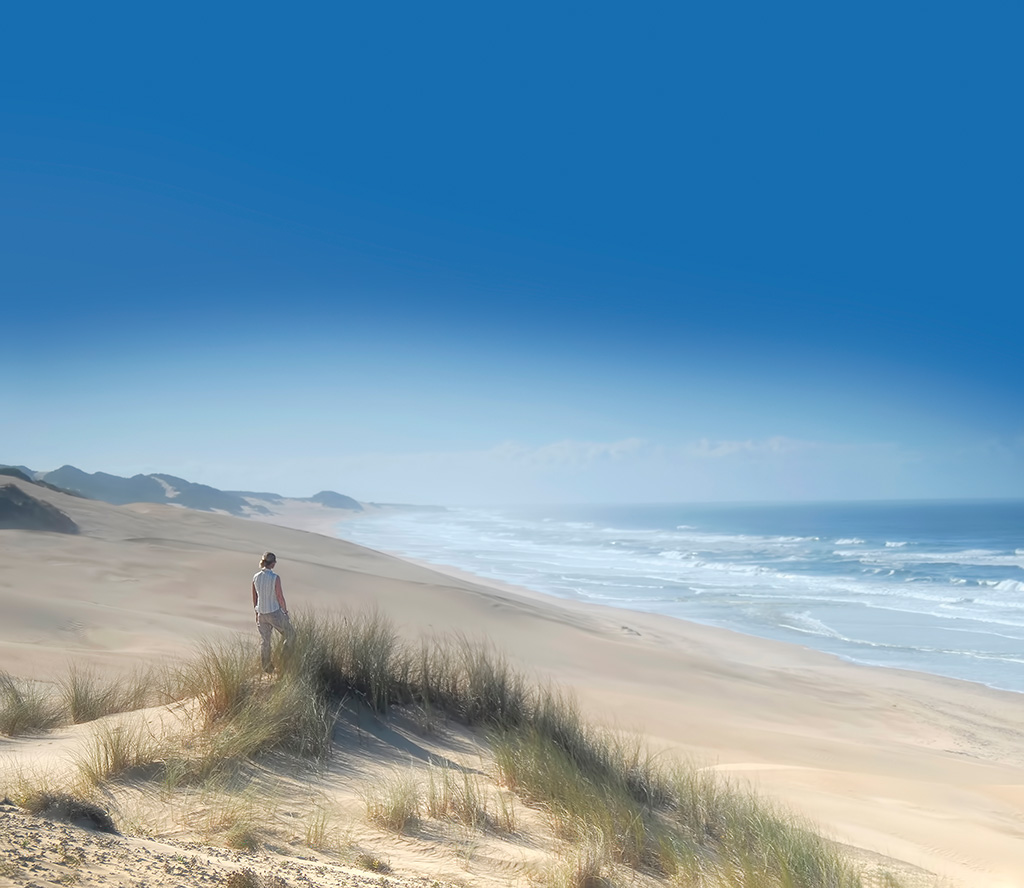
Addo’s coastal section where sand dunes and forests dominate
Algoa Bay marine protected area
‘The seven small islands of Algoa Bay are extremely important to many types of marine organisms,’ announced the boat’s skipper over a din of squawking birds. ‘They offer sanctuary to 4 000 penguins and are home to the only breeding population of roseate terns in the country. That rock over there,’ he said pointing to a small outcropping, ‘is the most easterly seal colony on the continent, and then there are these…’ He waved his hand around in a vague sweeping motion, indicating the gannets that were everywhere.
‘It’s hard to count them, but we figure there are around 250 000, which makes this the largest colony in the world.’
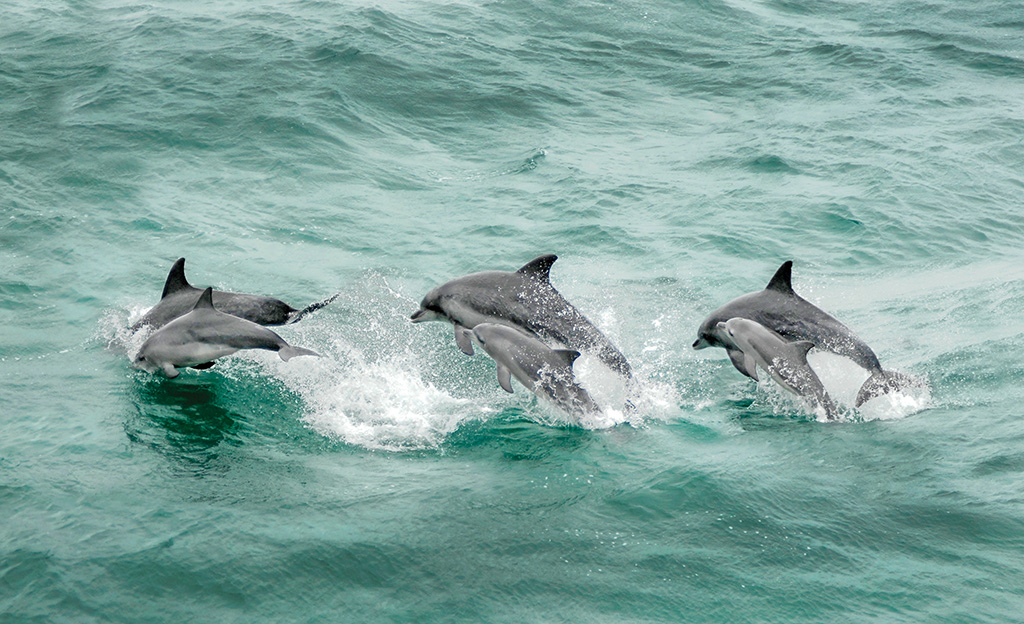
Common dolphins are regularly sighted in Addo’s Marine Protected Area
The 1 200km2 Algoa Bay Marine Protected Area (MPA) with its islands and undeveloped coast, are not only safeguarding the future of marine mammals, birds and fish stocks in the Eastern Cape, but also that of abalone and great white sharks, too. The latter can be met face to face on a newly launched cage-diving operation out of Gqeberha (Port Elizabeth).
The following day I went back out to sea, but this time with Pro Dive, a scuba-diving outfit with a licence to operate within the MPA. Here we explored a submerged pinnacle near St Croix Island named Evan’s Peak, where all manner of fabulous creatures reside.

Seals and many other ocean mammals – including great white sharks – call Addo their home
There were bright orange sponges and vibrant soft corals, as well as fish of all shapes and colours, the most exciting of which was a large ragged-toothed shark which glided slowly past. I watched her sink into the darker depths below and had to ask myself the question: ‘Can this really be Addo Elephant National Park? But it is.
Addo’s Humble beginnings & growth
Once, not so very long ago, South Africans knew Addo only as a smallish safari destination where you could drive through dense brush and be guaranteed of an elephant encounter or two. A nice weekend add-on to a Garden Route vacation.
But since its humble beginnings in the 1930s as a 2 000-hectare ‘zoo’ built for a handful of beleaguered elephants, Addo has steadily grown in both size and purpose.

A portion of the giant Cape gannet colony that inhabits the aptly named Bird Island in Algoa Bay.
Now in 2021, after numerous expansions, the park is almost 3 000km2 and has a mission to save not only elephants (of which there are now some 700 individuals) but also to preserve numerous endangered biomes.
Addo has six distinct habitats (Nama Karoo, fynbos, forest, subtropical thicket, coastal and marine) and a kaleidoscope of residents ranging from perlemon and pufferfish to rhino, lion and hyena.
I recently set out with my family to explore all eight of Addo’s varied sectors, from the glittering shores of Darlington Dam in the Karoo, all the way down to the rolling dunes and rocky islets of the southern coastal region. We hiked and we boated, we drove and we rode on horses and at the end of our 10-day jaunt, concluded that Addo surely has to be the most varied and diverse national park in all of Africa – if not the world.

Expect to see plenty of zebras in Addo.
Addo’s core
The two primary game drive areas (Colchester and Main Camp sectors) have a bit of a reputation for being clogged up with impenetrable thicket but there are some decent circuit routes where this notorious vegetation gives way to open landscapes alive with zebra, hartebeest, buffalo, and of course, elephants. On the Gorah Loop, along with several routes situated in the southern Colchester sector, you’ll also likely get good wildlife sightings, including black rhinos, hyena, and lions.
We spent two days in this core area, staying at the cute cottages of the Matyholweni Rest Camp from which we ventured out on well-graded roads. We ticked off meerkats and secretary birds, warthogs and bat-eared foxes, and we even saw a lion lazing in the open; a magnificent specimen with a big black Kalahari mane.

Coastal dunes near the Sundays River mouth.
There’s plenty to keep you busy for a few days in this popular part of the park, and when not exploring in your own car, you can join an open vehicle guided game- or night drive, or hang out in an underground viewing hide right in front of an active waterhole. The elephant interactions there are pure joy to behold.
But as great as this all is, there is oh so much more to Addo than just game drives and the Big Five.
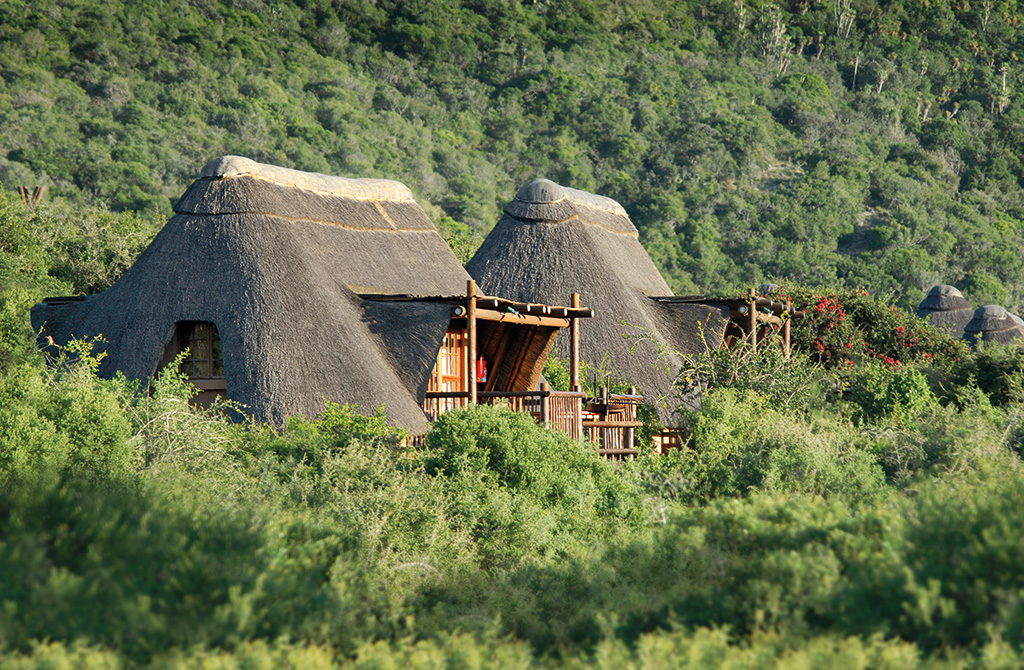
Thatched cottage accomodation at the Matyholweni Rest Camp in the Colchester section of Addo
Woody cape
Down in the coastal section known as the Woody Cape you can hike through evergreen forests, and desert-like scenery more akin to Namibia than what you might expect from the Eastern Cape.
If the thought of hiking 36km, much of it through soft sand, seems a bit much for you, fear not. You can still get a taste of what Woody Cape has on several easy forest trails situated close to the Langebos huts and the Umsintsi honeymoon cottage. Take a scenic drive to the coastal village of Canon Rocks where you’ll find a much less demanding 7km trail, or else access the dunes further west from the N2 at Colchester. This is just a short drive from the Matyholweni Rest Camp.

A young pair of meerkats frisking at sunrise.
Gorah Elephant Camp
Our next port of call was to the upmarket Gorah Elephant Camp; a gorgeous five-star lodge situated right in the middle of one of the most game-rich regions of Addo. Here we were treated to all the usual goodies you can expect from an exclusive safari experience: amazing food; beautiful accommodation, excellent guides and heaps of excursions into the surrounding bush.
Gorah operates on a private concession within the national park, so you’ll never have to share a sighting with the hoi polloi. The dam situated right in front of the lodge’s unfenced patio must have the sweetest water in all of Addo judging by the constant activity there; and at any time – day or night – we saw scores of elephants, buffalo and other thirsty game.
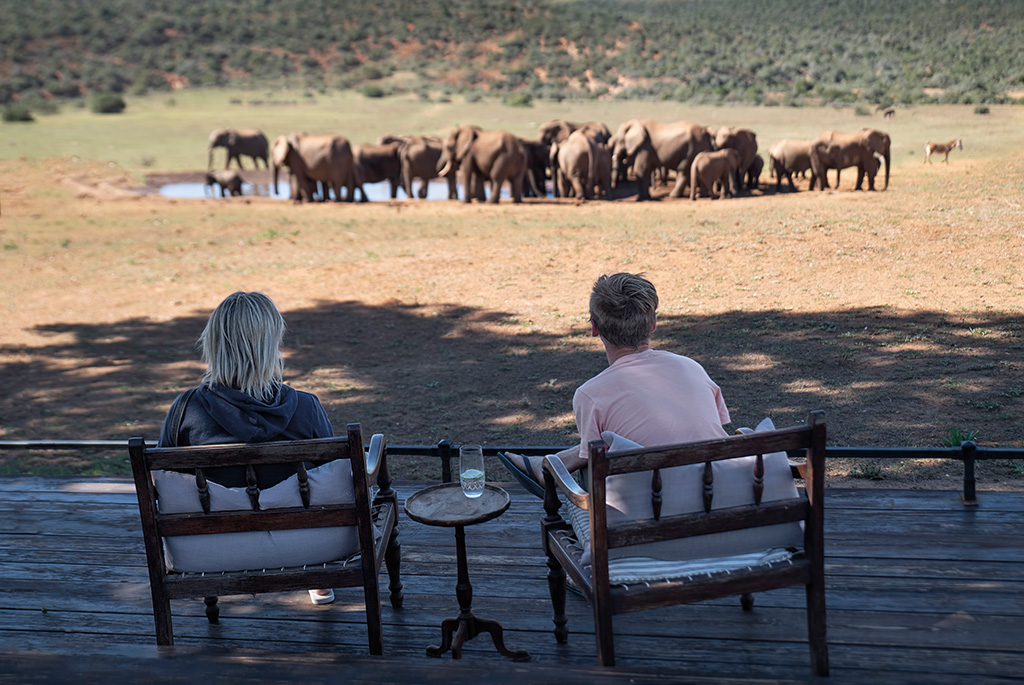
The waterhole in front of Gorah Elephant Camp is always busy with elephants and other game
We even got to spend some early-morning quality time on foot with a clan of habituated meerkats who allowed us to watch them from mere metres away.
To observe these little critters, lined up in front of the rising sun like little soldiers on inspection, was nothing short of enchanting.
Nyathi
North of Main Camp area you enter the 14 000-hectare Nyathi section, a place of secluded plains ensconced in valleys of forested mountains. The scenery here is quite different from the main game drive areas of Addo but alas, most of it is off limits to casual visitors due to the steep and muddy nature of the roads.
There are several ways to get into Nyathi, though. The first is to saddle up for one of the park’s twice daily horse treks (in the morning for novice riders, the afternoon for those with experience). I’m a fairly confident rider but as soon as Thando Ntamo, Addo’s horse whisperer, began his safety brief, I started to feel like I may have signed up for a suicide mission.
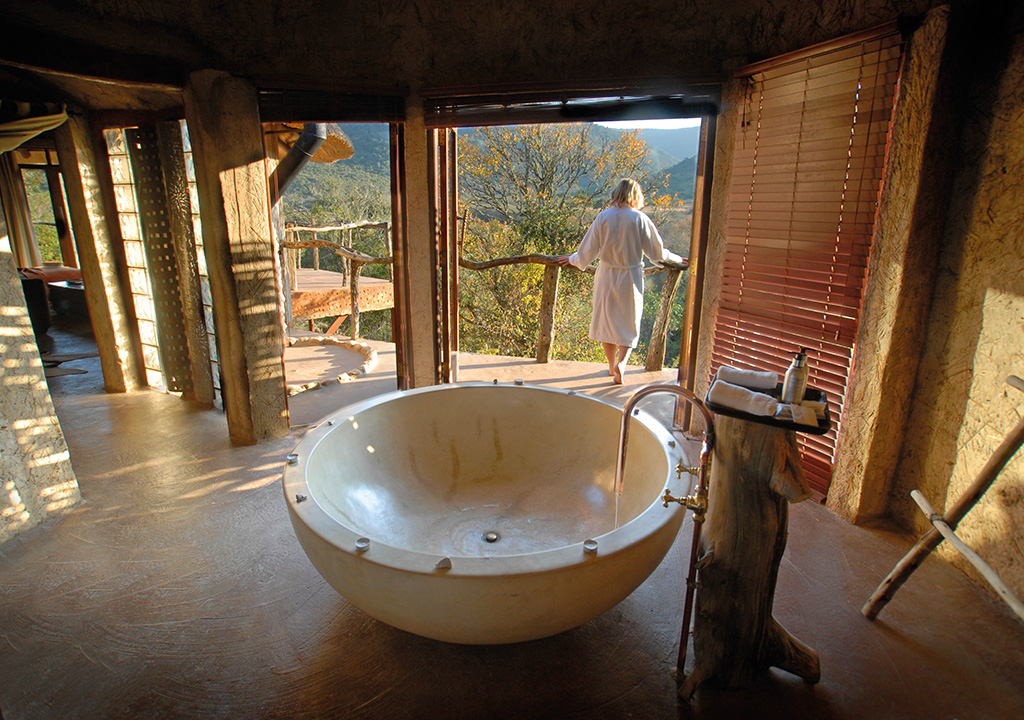
SANParks’ opulence at the beautifully situated Nyathi Rest Camp.
‘If you see a lion don’t gallop away. Instead, get off your horse. Hold the reins and stand your ground.’
Yeah right, I thought to myself. I can’t see myself doing that. But Thando had a very big rifle and a casual assuredness which inspired my trust and confidence.
The horses themselves were also as cool as cucumbers, even while surrounded by elephants, and although my palms were clammy and my jaw clenched tighter than a duck’s poophole for most of the two-hour excursion, I thoroughly enjoyed the thrill of riding among Addo’s big game. The fact that we didn’t see buffalo, lion or rhinos, I’ll consider a plus.

Succulents, fynbos and flowers dot the mountains on the Bedrogfontein 4×4 trail.
That same evening we stayed at SANParks’ version of luxury accommodation; a series of chic self-catering apartments situated on a bluff overlooking one of the most scenic areas of Nyathi. Another way to experience this region is to spend a night or two at the Riverbend Lodge; a five-star safari operator with an exclusive licence to conduct game drives throughout the sector.
Black rhinos are particularly fond of the dense vegetation found atop the Zuurberg foothills and, as the only vehicles likely to be able to traverse these steep roads would be a military tank or a Land Cruiser, it’s fortunate that Riverbend Lodge has a whole fleet of the latter vehicles.
Our guide took us up to the highest points where we drove from dung midden to dung midden (the rhino equivalent of a social media app) and eventually came face to face with one of these magnificent beasts. He snorted and crashed around a bit, before vanishing into a valley far, far below. It was magic. Pure, pure magic.

A family of elephants gathered around one of Addo’s many pumped waterholes.
Kabouga and Darlington
Next, we moved further north to the Kabouga and Darlington sections to try our own hand at an ‘off-road’ adventure on the 45km Bedrogfontien 4×4 trail. Commencing from the Kabouga House (a fully equipped self catering cottage) or from Mvubu (a basic bush camping site on the banks of the Sundays River) we set out into what felt like the absolute middle of nowhere.
Despite being the largest areas within Addo by far, the Darlington and Kabouga sections are rarely visited by tourists, because most of them are completely inaccessible. The Bedrogfontien route, which requires low range and high clearance, takes around six hours to complete. It winds through forests and over mountains made notorious by bloody Anglo Boer War battles, as well as traversing open Karoo panoramas where oryx eke out a living in a parched and arid land.
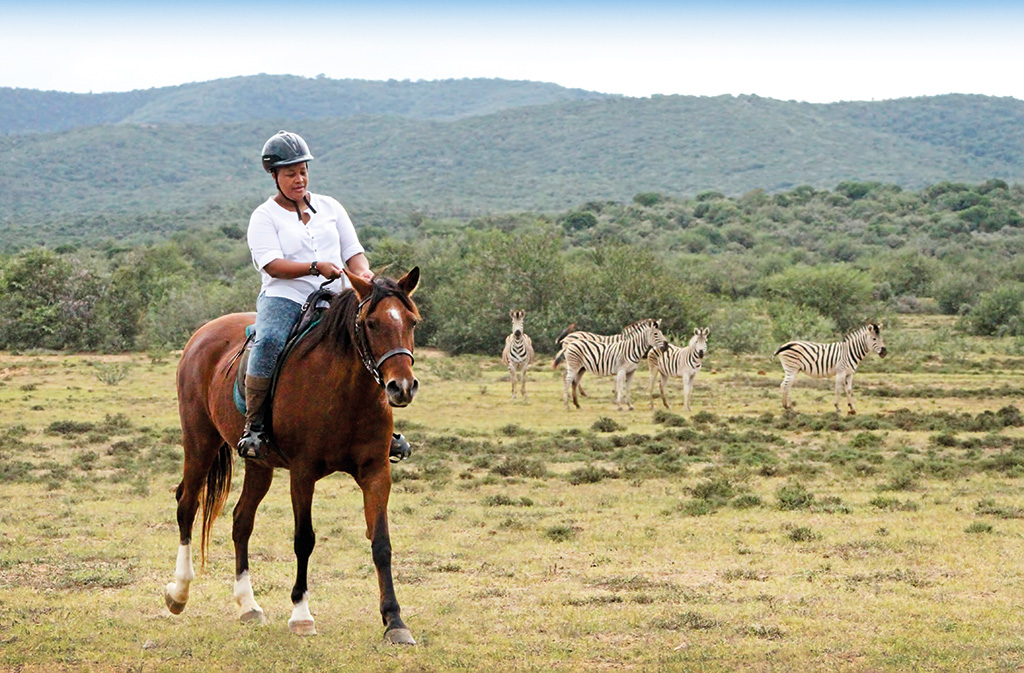
A good choice of ‘vehicle’ for exploring the mountainous Nyathi section
The fynbos-covered meadows, the expansive views and the blissful feeling of being surrounded by nature on all sides was so powerful at times that I felt inclined to leap from the car, swing my kids in circles and burst into a Von Trapp family song… but I didn’t because there were rhinos, elephants, and buffalo out there and they might have taken offence.
Concluding at the picturesque Darlington Dam where flamingos and hippos can sometimes be seen, we paused for a lakeside picnic and then headed off on public roads to our final port of call: the lovely Narina Bush Camp, situated in the Zuurberg section of Addo.

Darlington Dam in the extreme north-east of Addo
Zuurberg
Up there, in the grassy mountains, we found a special kind of peace. The fully equipped camp – which consists of four furnished army tents, a lapa and a heated bush shower – is situated beneath a verdant canopy of Afromontane forests. But take a steep hike upwards and you’ll soon find yourself in an open landscape of flowery fynbos, peppered with tall and ancient cycad trees.
There are yet more fynbos-focused Zuurberg hiking trails about half an hour drive north from Addo Main Gate up the scenic R335, and it was there, after 10 days of adventure, that I sat on a disused termite hill and drank in a fantastic 360-degree panorama.
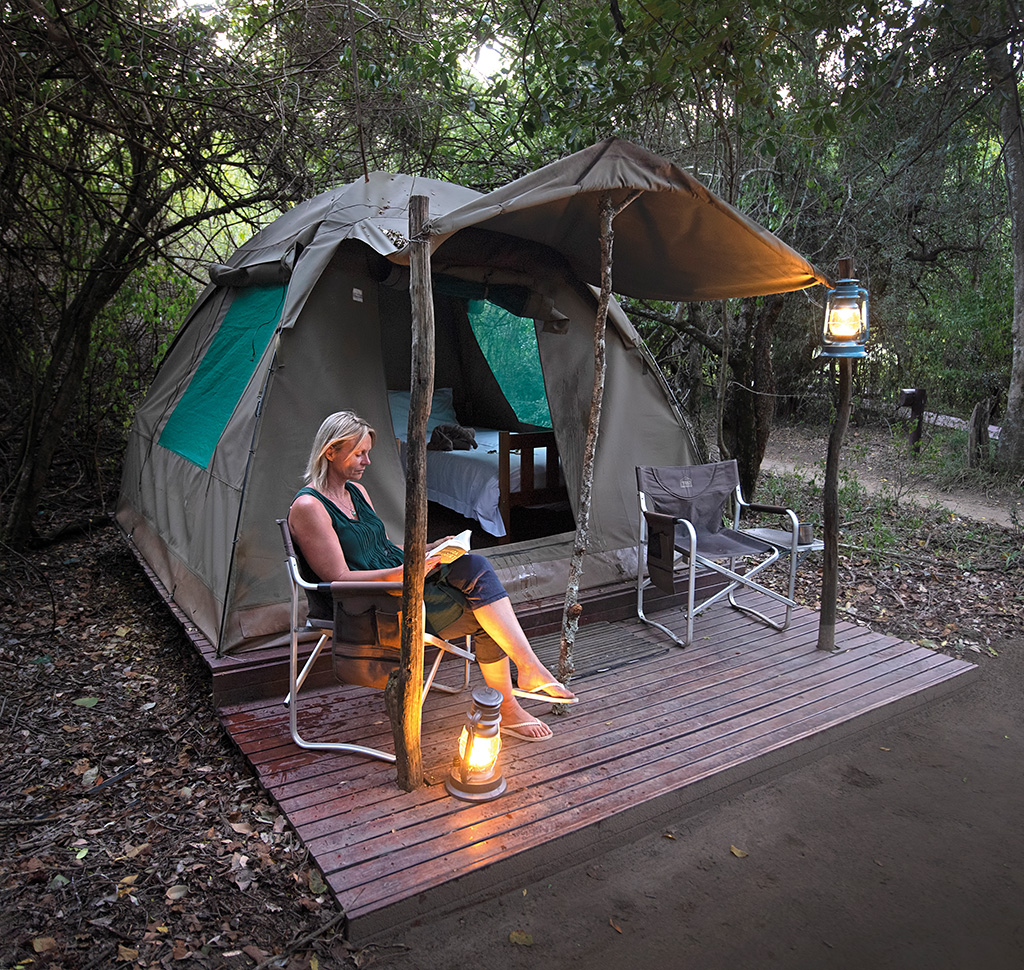
The lovely Narina Bush Camp is isolated and peaceful.
To the north lay the hazy horizons of the Great Karoo, while the east and west were filled with scenes of sloping mountains coated in fynbos and forests. To the south, through binoculars, I could just about see the sea and dunes of Algoa Bay along with the Bird Island lighthouse and its gannet-filled skies. It’s a huge expanse of protected habitats, alive as nature intended.
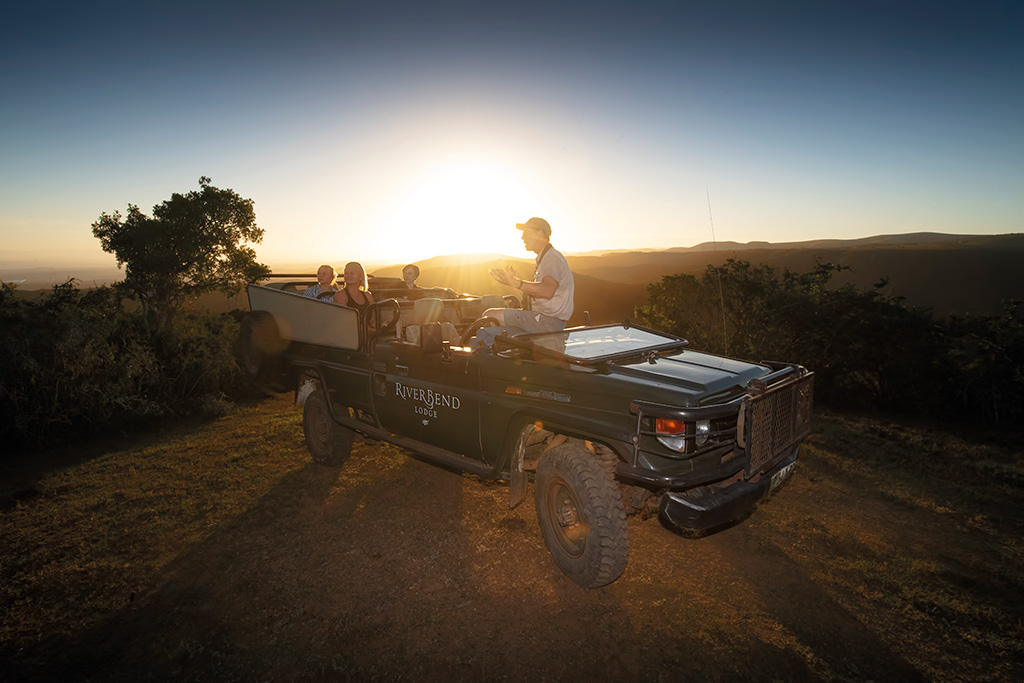
Enjoying a luxury safari in Nyathi courtesy of Riverbend Lodge.
At the start of our trip, 15 metres below the ocean, I had asked myself the question, ‘Can this really be Addo Elephant National Park?’
And there, up in the clouds, with sugarbirds and protea flowers all round, the answer was obvious. Yes, of course it is. This is Addo Elephant National Park… but it’s as much a place for sardines, trogons and yellowwoods as it is for those magnificent namesake pachyderms.
Trip Planner
Stay Here
There are 11 different SANParks lodging options inside Addo incuding:
Kabouga cottage (from R600pn for 2)
Mvubu campsite (R160 pn for first 2)
Narina Bush Camp (from R1 545 for 4)
Nyathi Rest Camp (from R2 110 for first 2)
Addo Main Camp (from R350 for a tent site – R1 780 for a two-bed chalet; R5 600 for a luxury six-person house)
Spekboom tented camp (R1 105 for 2)
Langebos Huts (From R1 770 base rate for 4 people)
Umsintsi honeymoon cottage (R965 for 2)
Matyholweni (from R1 695 for first 2)
Above rates exclude SANParks daily conservation fee of R86 per adult per day and R43 per child, per day.
sanparks.org

Gorah Elephant Camp
Riverbend Lodge currently has various special packages discounted by up to 55% for SA residents until September 2021.
riverbendlodge.co.za
Gorah Elephant Camp also has numerous special packages of up to 60% off until 31 August 2021 (and possibly beyond)
gorah.hunterhotels.com
If park accommodation is unavailable, there are countless private options on the boundaries of all of Addo’s sectors. You’ll find everything from basic campsites, to homely B&Bs and opulent private lodges. Google the name of the sector and ‘accommodation’ to find out what’s available nearby.
Do This
From Addo Main Camp reception, book:
Horse riding from R565 to R610 pp for a two-hour trek.
Guided game drives from R415 pp, duration approximately two hours.
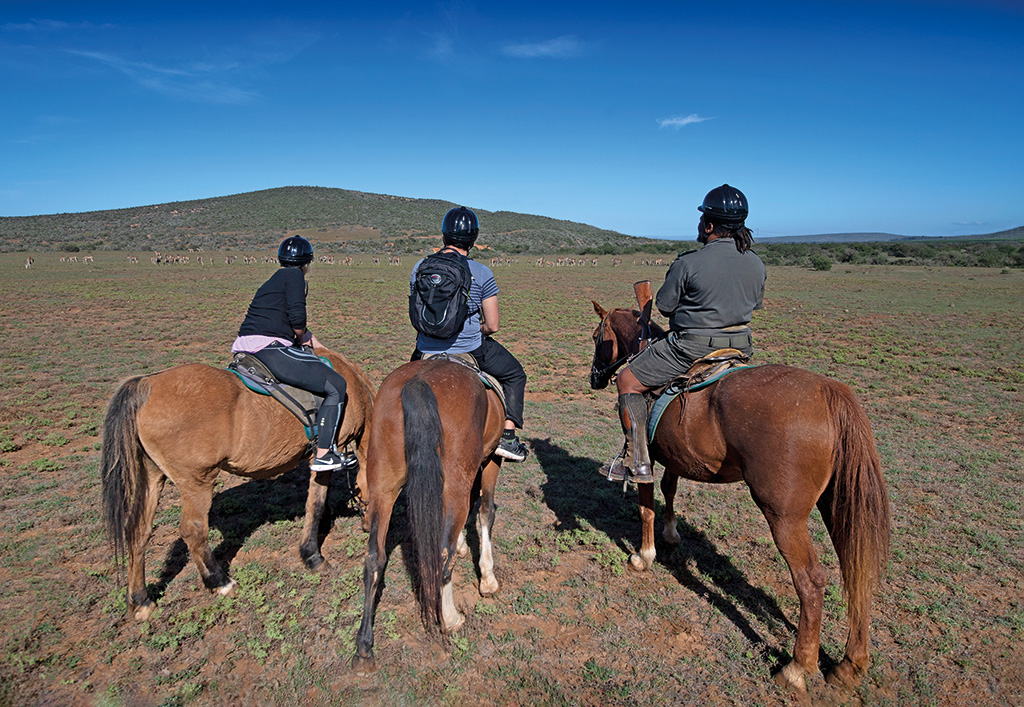
Horse riding in Addo
From Gqeberha (Port Elizabeth):
Raggy Charters runs various marine trips into the Algoa Bay and MPA starting at R1 700 pp
raggycharters.co.za
Scuba dive Evans Peak, from R595 pp.
prodive.co.za









